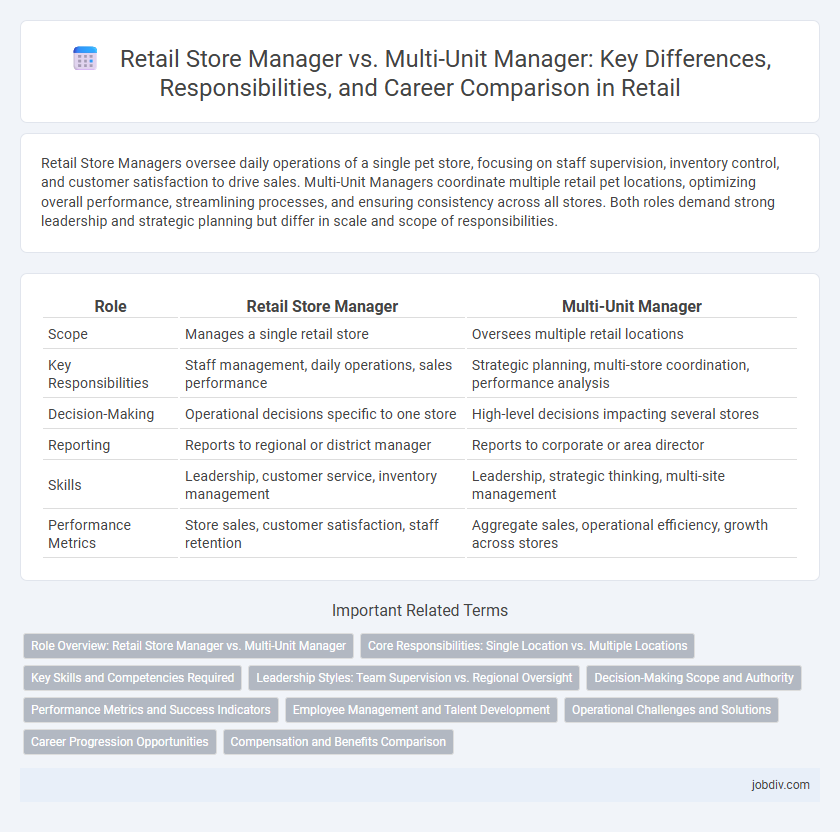Retail Store Managers oversee daily operations of a single pet store, focusing on staff supervision, inventory control, and customer satisfaction to drive sales. Multi-Unit Managers coordinate multiple retail pet locations, optimizing overall performance, streamlining processes, and ensuring consistency across all stores. Both roles demand strong leadership and strategic planning but differ in scale and scope of responsibilities.
Table of Comparison
| Role | Retail Store Manager | Multi-Unit Manager |
|---|---|---|
| Scope | Manages a single retail store | Oversees multiple retail locations |
| Key Responsibilities | Staff management, daily operations, sales performance | Strategic planning, multi-store coordination, performance analysis |
| Decision-Making | Operational decisions specific to one store | High-level decisions impacting several stores |
| Reporting | Reports to regional or district manager | Reports to corporate or area director |
| Skills | Leadership, customer service, inventory management | Leadership, strategic thinking, multi-site management |
| Performance Metrics | Store sales, customer satisfaction, staff retention | Aggregate sales, operational efficiency, growth across stores |
Role Overview: Retail Store Manager vs. Multi-Unit Manager
Retail Store Managers oversee daily operations, employee management, inventory control, and customer service for a single location, ensuring sales targets and store standards are met. Multi-Unit Managers strategically manage multiple retail stores, coordinating performance, administrative tasks, and staffing across locations to drive regional growth. Their leadership expands beyond individual stores, focusing on operational consistency and scalability across several branches.
Core Responsibilities: Single Location vs. Multiple Locations
A Retail Store Manager oversees daily operations, staff management, inventory control, and customer service within a single store, ensuring optimal performance and local profitability. In contrast, a Multi-Unit Manager coordinates multiple store locations, focusing on standardizing processes, managing regional staffing, and analyzing performance metrics across all sites. Both roles demand strong leadership but differ in scope, with Multi-Unit Managers prioritizing strategic oversight and consistency across various markets.
Key Skills and Competencies Required
Retail Store Managers excel in team leadership, inventory management, and customer service optimization, ensuring smooth daily store operations. Multi-Unit Managers require advanced skills in strategic planning, multi-location coordination, and performance analysis to drive growth across several retail outlets. Both roles demand strong communication, problem-solving abilities, and proficiency in sales metrics tracking to meet business objectives effectively.
Leadership Styles: Team Supervision vs. Regional Oversight
Retail Store Managers excel in hands-on leadership by directly supervising store teams, fostering individual employee development and maintaining daily operational efficiency. Multi-Unit Managers adopt a strategic leadership style, overseeing multiple store locations across regions, emphasizing consistency, scalability, and regional performance metrics. Effective Retail Leadership requires adaptability to shift between team-focused supervision and broader regional oversight to drive business growth.
Decision-Making Scope and Authority
Retail Store Managers oversee daily operations within a single location, exercising decision-making authority limited to staffing, inventory, and customer service decisions specific to that store. Multi-Unit Managers hold broader responsibility, directing strategic and operational decisions across multiple store locations, optimizing performance, resource allocation, and compliance on a regional or district scale. The scope of authority for Multi-Unit Managers includes higher-level budget management, cross-store marketing initiatives, and unified team leadership, emphasizing a wider influence than the more localized control of Store Managers.
Performance Metrics and Success Indicators
Retail Store Managers are primarily evaluated on store-level performance metrics such as sales volume, customer satisfaction scores, inventory turnover rates, and employee retention within a single location. Multi-Unit Managers oversee multiple stores, with success indicators including aggregate revenue growth, consistent operational standards across locations, and effective resource allocation to maximize profitability. Both roles emphasize leadership and efficiency, but Multi-Unit Managers require advanced skills in cross-location coordination and strategic scalability.
Employee Management and Talent Development
Retail Store Managers focus on direct employee management, including scheduling, performance coaching, and daily team motivation to ensure optimal store operations. Multi-Unit Managers oversee employee development across multiple locations, implementing standardized training programs and leadership development initiatives to foster talent growth consistently. Emphasizing strategic talent management, Multi-Unit Managers drive workforce engagement and retention on a broader scale compared to the hands-on approach of individual store managers.
Operational Challenges and Solutions
Retail store managers face operational challenges such as inventory control, staff scheduling, and maintaining customer satisfaction within a single location, requiring hands-on management and rapid problem-solving. Multi-unit managers tackle complexities across multiple stores, including standardizing procedures, optimizing supply chains, and coordinating larger teams, demanding strategic oversight and advanced data analytics. Implementing integrated retail management software and leveraging real-time performance metrics are effective solutions that enhance operational efficiency and enable scalable management across varying store environments.
Career Progression Opportunities
Retail Store Managers typically focus on overseeing the operations of a single store, developing skills in team leadership, inventory management, and customer service excellence. Multi-Unit Managers advance by managing several retail locations simultaneously, enhancing expertise in strategic planning, operational efficiency, and cross-store coordination. Career progression from Store Manager to Multi-Unit Manager offers expanded responsibilities and higher earning potential, making it a pivotal step in retail leadership development.
Compensation and Benefits Comparison
Retail Store Managers typically earn an average salary range of $45,000 to $65,000 annually, with benefits that often include health insurance, employee discounts, and performance bonuses. Multi-Unit Managers generally receive higher compensation, ranging from $70,000 to $110,000 per year, reflecting increased responsibilities overseeing multiple locations, along with enhanced benefits such as stock options, expanded health coverage, and travel allowances. Performance incentives and profit-sharing plans are more prevalent in multi-unit management roles, aligning compensation with the operational success of several retail stores.
Retail Store Manager vs Multi-Unit Manager Infographic

 jobdiv.com
jobdiv.com